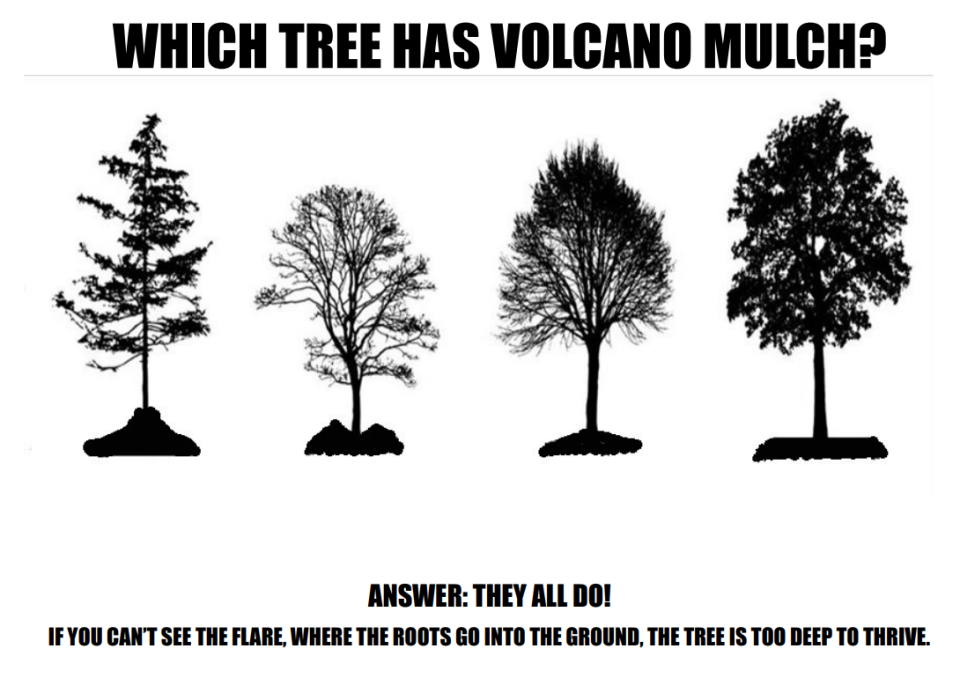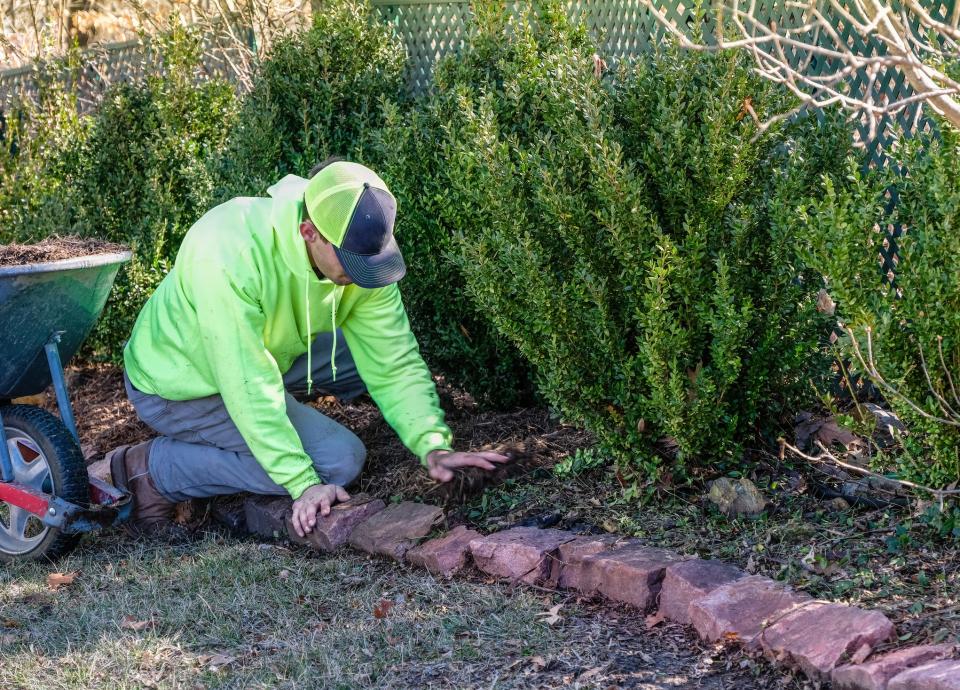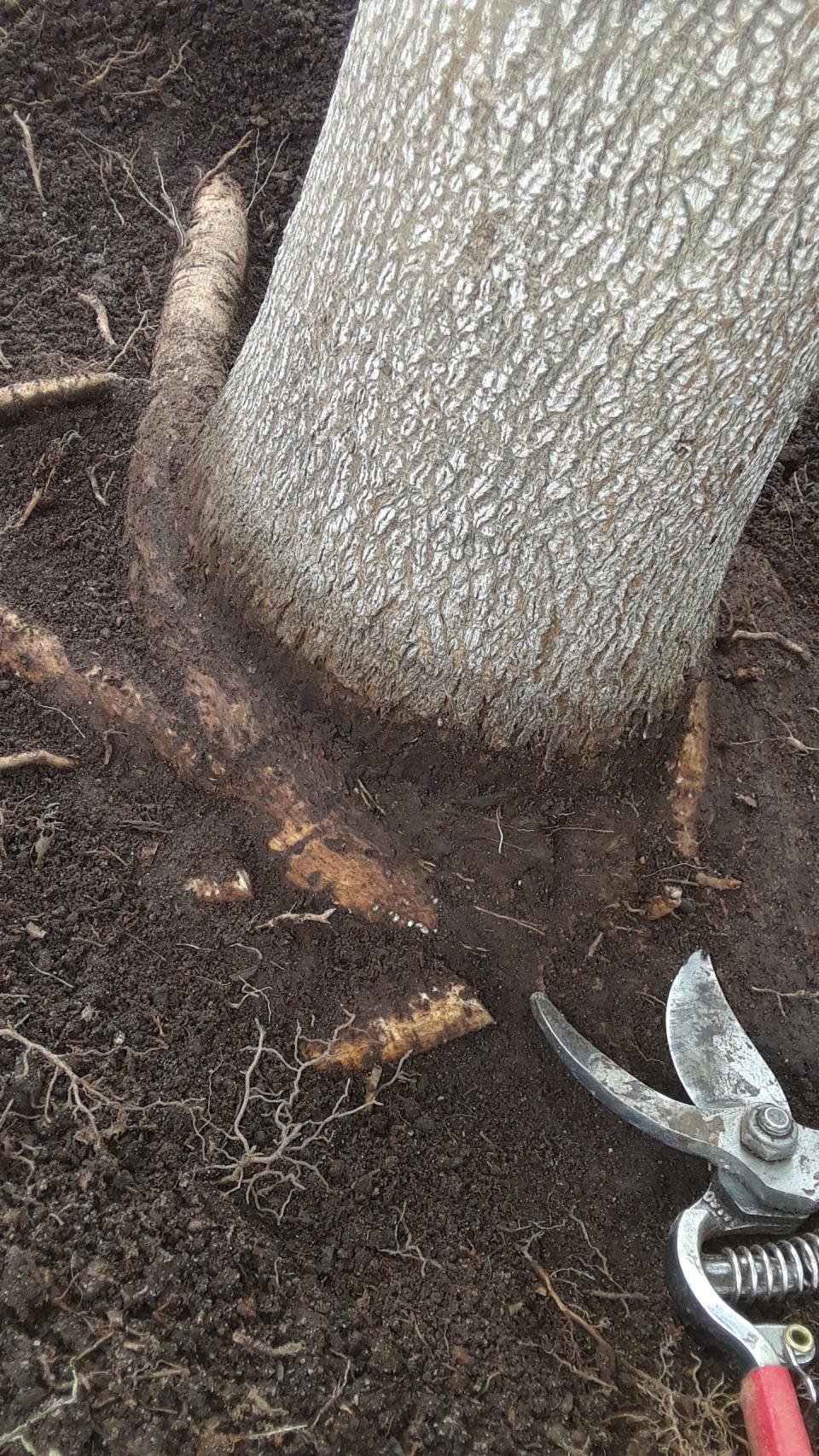Scrub Hub: Am I mulching the wrong way? Am I killing my trees with volcano mulch?
Editor's note: This story was originally published in 2022. We are republishing it ahead of spring landscaping season.
Most of us know that smell: fresh mulch. Similar to the scent of freshly cut grass or those new buds opening up, it signifies spring.
It’s that time of year where people are making their landscaping plans for the year. Homeowners have gotten a head start on spring cleaning with the few warm days we’ve seen across the state, and mulch orders are coming in left and right.
While March has recently come to a close — and I have lost my ability to appropriately use the pun mulch madness — we still need to talk about mulch.
Many homeowners may think of mulch as just a decorative feature of their yards, but it actually can do so much more. Mulch, if applied properly, can have several benefits for the trees and plants around them.
With that in mind, some of our readers want to know if the opposite can happen. They’ve asked the question about if mulch, done incorrectly, can actually hurt trees.
For this edition of the Scrub Hub, we’ve spoken with a couple of experts to better understand the impacts that mulch can have on tree health and if homeowners are mulching their trees the wrong way.
Short answer: Volcano mulch can kill your trees
Despite what you may think, there is a right way and a wrong way to mulch your trees. Not to be dramatic, but the wrong way can have dire consequences — and often does.
Elizabeth Jarvis, a certified tree steward with the Indiana Department of Natural Resources, said she has seen some of her own trees die because of how she planted them many years ago when she didn’t know better.
Forest health: Indianapolis' urban forests worth $258 million. But they are disappearing to development.
The problem is often called mulch mounding or volcano mulch. You know the look, where mulch is piled high up against the trunk of a tree. But it’s not just when mulch is mounded two feet up the tree. Even six inches or less can be a problem, according to Abby Krause, a former community and urban forestry coordinator with DNR.
“We definitely see it, it’s a really common thing,” she said. “Sometimes it’s really obvious where it’s feet up the tree, but in some cases it’s shallower and not as severe.”
The problems can be severe in either scenario, however.

Roots need water and oxygen for the tree to survive, so they spread out around the tree fairly close to the surface and don’t go very deep. When too much mulch is piled up around the tree, it restricts the amount of oxygen that the tree’s roots can access.
Volcano mulch also can lock in too much moisture, which promotes rot in the bark and creates a favorable environment for insects and fungal growth to enter the tree.
When mulch is mounded around a tree, particularly a younger one, that tree may actually send its roots upwards in search of oxygen and water. That means the roots grow up into the mulch and encircle the tree, rather than out into the surrounding soil.
Roots growing in that way strangle, or girdle, the tree. It will eventually kill the tree, Jarvis said, but it happens slowly over many years. And many people don’t discover the problem until it’s too late, she said.
“It makes me so sad driving around because I see all these trees with volcano mulch that essentially are dead trees walking, in my view,” Jarvis said.
The Scrub Hub: Your questions. Our answers.
Do you have questions about the environment? IndyStar environmental reporters Sarah Bowman and London Gibson want to hear from you.
Long answer: No more volcano shape, go with the donut
Just as there is a wrong way to mulch, there is a right way, too.
When done correctly, mulching can actually be really good for the trees. It provides a lot of benefits, such as helping to retain a desirable amount of moisture in the soil for roots to access. The mulch also can serve to moderate temperatures, keeping the soil cooler during hot summer days and warmer during the chilly winter ones.
Krause said urban soils often aren’t as healthy and nutrient-packed as their counterparts in more wooded areas. But as the mulch — which often is made from dead plant material such as compost, leaves and bark — breaks down, it provides a lot of organic matter and good nourishment to the soil to help trees grow.

Even more, mulch has a lot of preventative benefits. It blocks weeds from being able to grow too close to the trees. Mulch keeps soils from eroding or washing away and also stops the soils from crusting over, which makes it difficult for water and oxygen to infiltrate down to the roots.
Lastly, Krause said, it creates a barrier around the tree that impedes homeowners from getting close with their mowers or weed whackers, which can damage the tree if struck.
“A lot of the issues with urban trees are human-caused,” she said. “Mechanical damage from hitting trees, planting them too deep or volcano mulching around them.”
Scrub Hub: Why were dozens of trees cut down at Newfields' 100 Acres Park?
So if mulching can be good, homeowners want to know what the correct way is to do it.
The first and main takeaway, Krause said, is that mulch should never be touching the tree and its bark. Not even a little: “Instead of a volcano shape, it should be a donut.”

Mulch should not be up against the tree, but should be around it with at least several inches of clearance where the tree enters the soil. Krause said homeowners should still be able to see the root flare where the tree gets wider at the base before disappearing into the ground.
Other tips include not having the mulch be too thick everywhere else. It should be no more than two to four inches deep, according to Krause. Before applying new mulch every year, she recommends measuring how much is left over from the previous year because a resident might not need to reapply.
If you do need more or want the fresh look of dyed mulch, then go very lightly. Krause said to fluff up what’s already there before spreading a very thin layer on top.
Scrub Hub: What are more environmentally friendly alternatives to a lawn of grass
These tips aren’t just for homeowners, Jarvis said. Even if they aren’t applying their own mulch, the Indianapolis resident encourages homeowners to discuss these practices with their landscapers ahead of time.
And if you are in your home right now looking out at a mulch mound around one or more of your trees, it’s not too late — you can still take steps to help improve your tree’s health.
That’s why Jarvis started what is called the Great Hoosier Mulch-Off last year to raise awareness about tree health and mulching, and to spread the effort to un-mulch trees.

If the mulch has been freshly applied, homeowners can go out and pull it away from the trunk down to the root flare and give a clearance of at least six inches. If the mulch has been mounded for a few seasons, it may be caked over and much more difficult to remove, especially if the roots have grown up into it. On one such tree, Jarvis said it took her and a colleague more than an hour to remove all the mulch and prune some of the roots.
“It can be an involved thing,” Jarvis said, “but if you work your way back and do a bit at a time, it’s better than nothing and so important for the tree.”
In those scenarios and if you need an assist, she recommends seeking some expert help. You can reach Jarvis and the Great Hoosier Mulch-Off team at neighborhoodtreesindy@gmail.com with GHMO in the subject line — she said they are always happy to talk trees and provide a consultation.
Jarvis also recommends reaching out to your local Purdue extension office or a certified tree arborist to figure out next steps.
If you have more questions about tree health, or any other topics, let us know! You can ask us by submitting a question through our Google form below.
Can’t see the form? Click here.
Call IndyStar reporter Sarah Bowman at 317-444-6129 or email at sarah.bowman@indystar.com. Follow her on Twitter and Facebook: @IndyStarSarah. Connect with IndyStar’s environmental reporters: Join The Scrub on Facebook.
IndyStar's environmental reporting project is made possible through the generous support of the nonprofit Nina Mason Pulliam Charitable Trust.
This article originally appeared on Indianapolis Star: Homeowners are mulching the wrong way and hurting their trees
